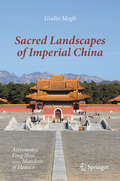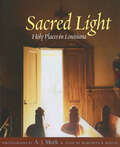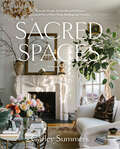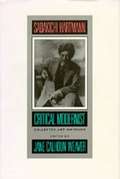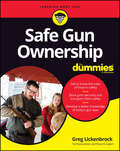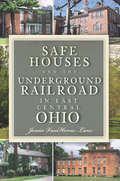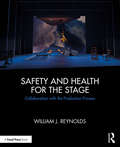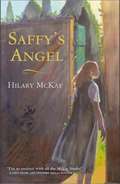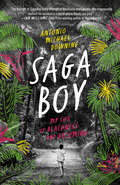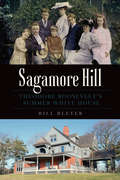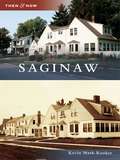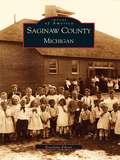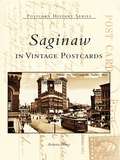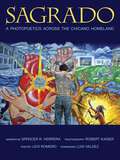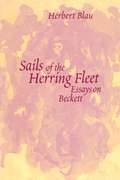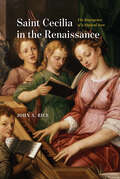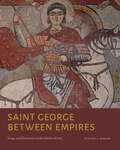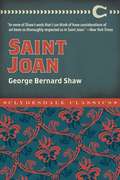- Table View
- List View
Sacred Images and Sacred Power in Byzantium (Variorum Collected Studies)
by Gary VikanIn these studies Gary Vikan has opened new perspectives on the daily life and material culture of Late Antiquity - more specifically, on icons and relics, and on objects revealing of the world of pilgrimage, the early cult of saints, and marriage. He contextualizes these familiar categories of object in the patterns of belief and ritual extracted from contemporary texts and the objects themselves, in order to understand their meaning within the everyday lives of those by whom and for whom they were made. The studies give a nuanced delineation of the inherently ambiguous boundary between conventional religion and magic, noting repeatedly those instances wherein the two are invoked in the same breath (and by way of the same art object), toward the same end. From this historically constructed matrix of art, belief, and ritual, the author derives an anthropologically defined paradigm of charisma and pilgrimage (applied in one essay, as an intriguing parallel, to deconstructing the world of a contemporary secular "saint," Elvis Presley).
Sacred Landscapes of Imperial China: Astronomy, Feng Shui, and the Mandate of Heaven
by Giulio MagliThis book analyses the magnificent imperial necropolises of ancient China from the perspective of Archaeoastronomy, a science which takes into account the landscape in which ancient monuments are placed, focusing especially but not exclusively on the celestial aspects. The power of the Chinese emperors was based on the so-called Mandate of Heaven: the rulers were believed to act as intermediaries between the sky gods and the Earth, and consequently, the architecture of their tombs, starting from the world-famous mausoleum of the first emperor, was closely linked to the celestial cycles and to the cosmos. This relationship, however, also had to take into account various other factors and doctrines, first the Zhao-Mu doctrine in the Han period and later the various forms of Feng Shui. As a result, over the centuries, diverse sacred landscapes were constructed. Among the sites analysed in the book are the “pyramids” of Xi’an from the Han dynasty, the mountain tombs of the Tang dynasty, and the Ming and Qing imperial tombs. The book explains how considerations such as astronomical orientation and topographical orientation according to the principles of Feng Shui played a fundamental role at these sites.
Sacred Light: Holy Places in Louisiana
by A. J. MeekRenowned photographer A. J. Meek takes the novitiate on an inspired visual journey with eighty-eight color photographs of the interiors of churches and synagogues located in south Louisiana, mostly along the lower Mississippi River valley. Tourists may crowd the famous European cathedrals such as Notre Dame in Paris and Westminster Abbey in London. Yet the splendors of local churches in America all too often remain cloistered and unheralded. Meek's beautiful photographs correct this oversight for Louisiana, a state that features a great many beautiful and long-standing holy places. Often incorporating long exposures and select framing, the images in the first section of Sacred Light encompass altars, chancels, and sanctuaries. The second section contains photographs of statues representing deities, angels, madonnas, and saints, often seen with intense color derived from stained-glass windows or artificial light. Light itself is the subject of the third and last section. In several photographs, light is transformed by a window into a kaleidoscope of color on a wooden pew or pulpit chair. Other times the light seems to radiate a living presence of its own. Additionally, the book includes an essay by Louisiana State University art historian and liturgical space consultant, Marchita B. Mauck. Sacred Light also contains photographs of some of the church and synagogue restoration projects after Hurricane Katrina. Meek relates that the now-famous storm of August 2005 was the shadow he was looking for that defines blessed light. He places emphasis on restoration, not destruction, as a testimony to the resilience of the human spirit.
Sacred Mirrors: The Visionary Art of Alex Grey
by Ken Wilber Carlo Mccormick Alex GreyThis unique series of paintings takes the viewer on a graphic, visionary journey through the physical, metaphysical, and spiritual anatomy of the self. From anatomically correct rendering of the body systems, Grey moves to the spiritual/energetic systems with such images as "Universal Mind Lattice," envisioning the sacred and esoteric symbolism of the body and the forces that define its living field of energy. Includes essays on the significance of Grey's work by Ken Wilber, the eminent transpersonal psychologist, and by the noted New York art critic, Carlo McCormick.
Sacred Spaces: Everyday People and the Beautiful Homes Created Out of Their Trials, Healing, and Victories
by Carley SummersA gorgeous photography collection, featuring home interiors and profiles of the people who have transformed these spaces into sanctuaries, calling you to create your own sacred space &“This book is brimming with heart and healing, and it is a moody, visual feast that will leave you feeling full in the best way possible.&”—Justina Blakeney, designer, author, and founder of JungalowBefore she became an internationally renowned designer and photographer, Carley Summers suffered from alcoholism and addiction, spending nights in jail, the emergency room, and rehab. As someone who celebrates recovery today, she knows firsthand the importance of a warm and inviting home. Summers uses her life experience and her craft to ensure that the homes she photographs and designs are comforting, healing spaces to live and grow in.Sacred Spaces takes readers on a beautifully photographed journey inside fourteen homes, from North Carolina and California to Canada, France, and Morocco, as Summers uncovers the vulnerable stories behind each one: a mother who uses her kitchen to heal her son with food, a woman who found her sanctuary after overcoming childhood abuse, and more. She even offers a tour of her mother&’s home and her own. Along the way, each section identifies a type of space that people have created, including• The Foundational Home, which features those who have created spaces on a solid foundation for a lasting legacy• The Wandering Home, which highlights people who were lost in life, lost in travels, but never lost in their home• The Cathartic Home, which showcases people who realize that when they cannot change the outside world, they can change the inside of their homes to bring comfort through renewal and restorationThis collection is a balm for those seeking refuge in a world fraught with struggle and heartache. Through stories of brokenness, hurt, and healing, Sacred Spaces invites readers to dream of the home that will set them free.
Sacrificing Soldiers on the National Mall
by Kristin Ann HassFor the city’s first two hundred years, the story told at Washington DC’s symbolic center, the National Mall, was about triumphant American leaders. Since 1982, when the Vietnam Veterans Memorial was dedicated, the narrative has shifted to emphasize the memory of American wars. In the last thirty years, five significant war memorials have been built on, or very nearly on, the Mall. The Vietnam Veterans Memorial, the Korean War Veterans Memorial, the Women in Military Service for America Memorial, The National Japanese American Memorial to Patriotism During WWII, and the National World War II Memorial have not only transformed the physical space of the Mall but have also dramatically rewritten ideas about U.S. nationalism expressed there. In Sacrificing Soldiers on the National Mall, Kristin Ann Hass examines this war memorial boom, the debates about war and race and gender and patriotism that shaped the memorials, and the new narratives about the nature of American citizenship that they spawned. Sacrificing Soldiers on the National Mall explores the meanings we have made in exchange for the lives of our soldiers and asks if we have made good on our enormous responsibility to them.
Sacs à main en papier mousse EVA : Pâques
by Karina RamirezCréez d’incroyables sacs à main en papier mousse EVA ! Le livre Sacs à main en papier mousse EVA : Pâques va vous montrer étape par étape comment créer d’incroyables sacs à main en papier mousse EVA avec différents personnages. Apprenez la technique sans problème grâce au processus expliqué de A à Z afin que vous puissiez fabriquer autant de sacs que vous le souhaitez. Ce livre est un excellent allié dans toutes sortes de situations : Vous pouvez fabriquer ces sacs à main originaux pour vos amis, votre famille ou vos connaissances. Vous pouvez ajouter des bonbons ou d’autres petites surprises afin de créer un cadeau original pour un anniversaire, un mariage, Pâques, Noël, Halloween, une première communion, un baptême ou d’autres événements. Passez un super moment avec vos enfants en leur expliquant les étapes qu’ils doivent suivre pour créer un sac à main. Vous pouvez être fier que vos enfants achèvent un sac à main si drôle et si mignon. Préparez des activités extrascolaires avec vos enfants et apprenez-leur la valeur de la créativité, de la responsabilité et du travail artistique. Un livre pour un incroyable divertissement en famille ! ***Tous les patrons sont inclus dans le livre.***
Sadakichi Hartmann, Critical Modernist: Collected Art Writings
by Jane Calhoun WeaverBrilliant and controversial, art critic Sadakichi Hartmann wrote copiously about American and European art and the shaping of American culture during the decades from 1890 to 1910. Jane Weaver has recovered and assembled over fifty of Hartmann's critical writings from influential, though often obscure, turn-of-the-century journals. These reviews and theoretical essays not only provide some of the earliest known criticism of important artists and photographers of the period, but also make Hartmann's fundamental- and uniquely American- definition of modernism available to students of art and cultural history. A most useful adjunct to the text is a complete bibliography of Hartmann's writings on art, as well as an annotated checklist of all the artists treated by Hartmann in this book. Sadakichi Hartmann (1867-1944), half German, half Japanese, learned the American cast of mind and heart as a beloved young disciple of the aged Walt Whitman. Reflecting the poet's zealous vision, Hartmann's piercing commentaries on the art centers of Boston and New York offer unparalleled documentation of the years before and after 1900.
Safe Gun Ownership For Dummies
by Greg LickenbrockA straightforward guide to being smart with your firearm With gun sales at an all-time high in the U.S., easy-to-understand advice on storing and possessing guns safely is at an all-time premium. Safe Gun Ownership For Dummies paves the way for new and novice gun owners to learn the basics of firearm ownership in a non-partisan tone. This book helps gun owners thoroughly explore the rules of gun safety and adopt the habits of savvy firearm aficionados. Written by a firearms expert and analyst who has reviewed hundreds of firearms along with gun safety and storage options, this guide helps you develop a safety mindset and apply practices to assure you and your family avoid harm. Learn, internalize, and apply the rules of gun safety Understand federal, state, and local gun laws Find a good gun safety course for hands-on practice Store and transport your firearm securelyWhen it’s time to start training on your new firearm and the safety rules of gun ownership, Safe Gun Ownership For Dummies is at the ready with everything you need to know to make safety your aim.
Safe Houses and the Underground Railroad in East Central Ohio
by Janice Vanhorne-LaneFor slaves fleeing captivity, the Underground Railroad was the most viable means of escape, and with over three thousand miles of clandestine routes and secret trails, Ohio had the country's most extensive network of safe houses. A great number of these passageways were concentrated throughout the state's east central region, particularly the inland channels of Coshocton, Holmes and Guernsey Counties and the now-famous canal route, a major conduit winding through Tuscarawas and Stark Counties. Similarly, runaways sought refuge in the hills and valleys of Harrison County, as well as in the Quaker stronghold of Columbiana County. Using the letters of Wilbur H. Seibert, along with contemporary photographs of area safe houses, Janice VanHorne-Lane provides an intimate account of east central Ohio's profound contributions to the Underground Railroad and its mission, freedom for all.
Safety Orange (Forerunners: Ideas First)
by Anna Watkins FisherHow fluorescent orange symbolizes the uneven distribution of safety and risk in the neoliberal United States Safety Orange first emerged in the 1950s as a bureaucratic color standard in technical manuals and federal regulations in the United States. Today it is most visible in the contexts of terror, pandemic, and environmental alarm systems; traffic control; work safety; and mass incarceration. In recent decades, the color has become ubiquitous in American public life—a marker of the extreme poles of state oversight and abandonment, of capitalist excess and dereliction. Its unprecedented saturation encodes the tracking of those bodies, neighborhoods, and infrastructures judged as worthy of care—and those deemed dangerous and expendable. Here, Anna Watkins Fisher uses Safety Orange as an interpretive key for theorizing the uneven distribution of safety and care in twenty-first-century U.S. public life and for pondering what the color tells us about neoliberalism&’s intensifying impact often hiding in plain sight in ordinary and commonplace phenomena. Forerunners: Ideas First is a thought-in-process series of breakthrough digital publications. Written between fresh ideas and finished books, Forerunners draws on scholarly work initiated in notable blogs, social media, conference plenaries, journal articles, and the synergy of academic exchange. This is gray literature publishing: where intense thinking, change, and speculation take place in scholarship.
Safety and Health for the Stage: Collaboration with the Production Process
by William J. ReynoldsSafety and Health for the Stage: Collaboration with the Production Process is a practical guide to integrating safety and health into the production process for live entertainment in the context of compliance with applicable codes, standards, and recommended practices. This book explores the need for safety and health to become an integral aspect of theatre production and live entertainment, focusing on specific steps to take and policies to employ to bring a safety and health program into full collaboration in the production process. Readers will learn how to comply with legal codes and standards as they initiate and implement an effective safety and health program in their theatre production organization or academic theatre department. The book includes references and links to other industry-specific safety and health resources, as well as a Glossary of Safety and Health Terms to navigate the safety and health jargon in the context of theatre and live entertainment. Safety and Health for the Stage: Collaboration with the Production Process provides links to electronic versions of sample safety and health programs, industry-specific policies and recommended practices, and forms and templates related to many of the topics covered in the book. Written for practitioners who are engaged in all aspects of theatre production and live entertainment, as well as educators who train and influence the next generations of these practitioners, this book is an essential resource for creating a positive culture of safety in live entertainment.
Saffy's Angel (Casson Family #1)
by Hilary MckayThe four Casson children, whose mother, Eve, is a fine-arts painter, have all been given the names of paint colors. Cadmium (Caddy), is the eldest; then Saffron (Saffy); Indigo, the only boy; and Rose, the youngest. When Saffy discovers quite by accident that she has been adopted, she is deeply upset, though the others assure her that it makes no difference at all. Saffy is the daughter of Eve's twin sister, who lived in Siena, Italy, and died in a car crash. Grandad brought Saffy, as a very small child, back from Siena. At Grandad's death he leaves something to each of the children. To Saffy, it is "her angel," although no one knows its identity. How Saffy discovers what her angel is, with the help of an energetic new friend, lies at the heart of this enchanting story. Unforgettable characters come alive in often deeply humorous and always absorbing events to be treasured for a long, long time.
Saga Boy: My Life of Blackness and Becoming
by Antonio Michael DowningThe triumph of Saga Boy is the triumph of Blackness everywhere--the irrepressible instinct for survival in a world where Blacks are prey."--Ian Williams, Giller Prize-winning author of ReproductionAn enthralling, deeply personal account of a young immigrant's search for belonging and black identity amid the long-lasting effects of cultural dislocation.Antonio Michael Downing's memoir of creativity and transformation is a startling mash-up of memories and mythology, told in gripping, lyrical prose. Raised by his indomitable grandmother in the lush rainforest of southern Trinidad, Downing, at age 11, is uprooted to Canada when she dies. But to a very unusual part of Canada: he and his older brother are sent to live with his stern, evangelical Aunt Joan, in Wabigoon, a tiny northern Ontario community where they are the only black children in the town. In this wilderness, he begins his journey as an immigrant minority, using music and performance to dramatically transform himself. At the heart of his odyssey is the longing for a home. He is re-united with his birth parents who he has known only through stories. But this proves disappointing: Al is a womanizing con man and drug addict, and Gloria, twice abandoned by Al, seems to regard her sons as cash machines. He tries to flee his messy family life by transforming into a series of extravagant musical personalities: "Mic Dainjah", a punk rock rapper, "Molasses", a soul music crooner and finally "John Orpheus", a gold chained, sequin- and leather-clad pop star. Yet, like his father and grandfather, he has become a "Saga Boy", a Trinidadian playboy, addicted to escapism, attention, and sex. When the inevitable crash happens, he finds himself in a cold, stone jail cell. He has become everything he was trying to escape and must finally face himself. Richly evocative, Saga Boy is a heart-wrenching but uplifting story of a lonely immigrant boy who overcomes adversity and abandonment to reclaim his black identity and embrace a rich heritage.
Sagamore Hill: Theodore Roosevelt's Summer White House (Landmarks)
by Bill BleyerNo house better reflects the personality and interests of its owner than Theodore Roosevelt's cherished Sagamore Hill. After Roosevelt returned to Oyster Bay following the death of both his beloved wife and mother, he and his second wife, Edith, made the house a home for their growing and rambunctious family. What began as the perfect getaway from unhealthy New York City summers in his grandfather's day became the Summer White House during Roosevelt's presidency. He hosted political guests like Henry Cabot Lodge and cultural luminaries like novelist Edith Wharton. Roosevelt spent his final years happily at Sagamore Hill, and after his death in 1919, the Theodore Roosevelt Association and the National Park Service preserved the house. With previously unpublished photographs and a detailed guide to the house and grounds, historian Bill Bleyer recounts bygone days at Roosevelt's haven.
Saginaw
by Kevin Mark RookerSaginaw is the hub of mid-Michigan and had its beginnings in the 1820s with the establishment of Fort Saginaw near present-day Court and Hamilton Streets. Owing to the lumber industry, two separate cities developed along the banks of the Saginaw River: the west side city of Saginaw and East Saginaw. Intense rivalry resulted in rapid population growth and many civic improvements for both. Consolidation of the Saginaws occurred in 1890, and continued prosperity followed the ebb and flow of the lumber and automotive industries.
Saginaw County, Michigan
by Roselynn EdererAs part of the Northwest Territory, the Saginaw wilderness was not organized into a county until January 28, 1835. When Canadian, Scottish, German, and Irish pioneers began to settle along the region's many rivers, small communities developed-Burt, Birch Run, Bridgeport, Frankenmuth, Freeland, Hemlock, Merrill, St. Charles, Chesaning, Oakley, and Zilwaukee-in addition to larger towns such as Carrollton, Saginaw City, and East Saginaw. Using stories and photographs collected from life-long residents and historical societies throughout Saginaw County, this book documents the colorful lumbering, agricultural, and industrial past of these communities from the mid-1800s through the early 1900s.
Saginaw in Vintage Postcards (Postcard History)
by Roberta MoreyBecause of its excellent river system, Saginaw developed from an Indian village into a bustling lumber town. In its early days, investors came from eastern cities and became wealthy lumber barons. They built beautiful mansions, hotels, and public buildings while they also supported civic projects. Before consolidating, there were two cities: East Saginaw and Saginaw City, separated by the Saginaw River. Many German societies, schools, and churches were organized in the area, due to the large number of residents with a German heritage. The early residents survived fires, floods, and the end of the lumber boom. Other industries developed and the city continued to grow. The rare postcards that appear in this book depict many historical buildings, the two separate cities, the German influence, and the philanthropy of the lumber barons. Join author Roberta Morey on a journey through Saginaw's rich industrial and cultural history.
Saginaw: Labor and Leisure
by Roberta MoreySaginaw boasts a rich and colorful history. After the early explorers and small Native American villages came the lumbermen, shanty boys, and a bustling commercial center. Later the coal, salt, and sugar beet industries replaced lumbering in the economy. Many of Saginaw's businesses were known worldwide and are still important after more than 100 years. Saginaw was home to a bevy of famous and infamous characters. Among the early ruffians were Fabian Fournier (Saginaw's Paul Bunyan), Silver Jack Driscoll, and the Opera House Rogue, Warren Bordwell. Saginaw's more illustrious residents include "King Clothier," Little Jake Seligman, educator Alice Freeman Palmer, boxer George "Kid" Lavigne, and many others. Many of the postcards in this book represent the businesses and personalities that made Saginaw's distinctive character what it is today.
Sagrado: A Photopoetics Across the Chicano Homeland (Querencias Series)
by Spencer R. Herrera Romero LeviUn lugar sagrado, a sacred place where two or more are gathered in the name of community, can be found almost anywhere and yet it is elusive: a charro arena behind a rock quarry, on the pilgrimage trail to Chimayó, a curandero&’s shrine in South Texas, or at a binational Mass along the border. Sagrado is neither a search for identity nor a quest for a homeland but an affirmation of an ever-evolving cultural landscape. Embedded at the heart of this remarkable book, in which prose, photographs, and poems complement each other, is a photopoetic journey across the Chicano Southwest.
Sails of the Herring Fleet
by Herbert BlauSails of the Herring Fleet traces esteemed director and theorist Herbert Blau's encounters with the work of Samuel Beckett. Blau directed Beckett's plays when they were still virtually unknown, and for more than four decades has remained one of the leading interpreters of his work. In addition to now-classic essays, the collection includes early program notes and two remarkable interviews -- one from Blau's experience directing Waiting for Godot at San Quentin prison, and one from his last visit with Beckett, just before the playwright's death. Herbert Blau is Byron W. and Alice L. Lockwood Professor of the Humanities, University of Washington.
Saint Cecilia in the Renaissance: The Emergence of a Musical Icon
by John A. RiceThis study uncovers how Saint Cecilia came to be closely associated with music and musicians. Until the fifteenth century, Saint Cecilia was not connected with music. She was perceived as one of many virgin martyrs, with no obvious musical skills or interests. During the next two centuries, however, she inspired many musical works written in her honor and a vast number of paintings that depicted her singing or playing an instrument. In this book, John A. Rice argues that Cecilia’s association with music came about in several stages, involving Christian liturgy, visual arts, and music. It was fostered by interactions between artists, musicians, and their patrons and the transfer of visual and musical traditions from northern Europe to Italy. Saint Cecilia in the Renaissance explores the cult of the saint in Medieval times and through the sixteenth century when musicians’ guilds in the Low Countries and France first chose Cecilia as their patron. The book then turns to music and the explosion of polyphonic vocal works written in Cecilia’s honor by some of the most celebrated composers in Europe. Finally, the book examines the wealth of visual representations of Cecilia especially during the Italian Renaissance, among which Raphael’s 1515 painting, The Ecstasy of Saint Cecilia, is but the most famous example. Thoroughly researched and beautifully illustrated in color, Saint Cecilia in the Renaissance is the definitive portrait of Saint Cecilia as a figure of musical and artistic inspiration.
Saint George Between Empires: Image and Encounter in the Medieval East
by Heather A. BadamoThis volume examines Saint George’s intertwined traditions in the competing states of the eastern Mediterranean and Transcaucasia, demonstrating how rival conceptions of this well-known saint became central to Crusader, Eastern Christian, and Islamic medieval visual cultures.Saint George Between Empires links the visual cultures of Byzantium, North Africa, the Levant, Syria, and the Caucasus during the Crusader era to redraw our picture of interfaith relations and artistic networks. Heather Badamo recovers and recontextualizes a vast body of images and literature—from etiquette manuals and romances to miracle accounts and chronicles—to describe the history of Saint George during a period of religious and political fragmentation, between his “rise” to cross-cultural prominence in the eleventh century and his “globalization” in the fifteenth. In Badamo’s analysis, George emerges as an exemplar of cross-cultural encounter and global translation.Featuring important new research on monuments and artworks that are no longer available to scholars as a result of the occupation of Syria and parts of Iraq, Saint George Between Empires will be welcomed by scholars of Byzantine, medieval, Islamic, and Eastern Christian art and cultural studies.
Saint Joan: Her History And The Play (Clydesdale Classics)
by George Bernard ShawRediscover the story of the inspirational Saint Joan of Arc with the classic play by George Bernard Shaw. The historical saint begins her story as a simple country girl in fifteenth century France who is inspired by visions from God to help liberate her country from the English. She secures soldier&’s clothing and convinces the soon-to-be king, Charles, to begin battling for his country. Though her regiment succeeds in battle after battle, her enemies (the English) move against her. When Joan moves to liberate Paris from the English control—against the advice of her friends—she is captured and tried for heresy. Despite help from a Bishop and the Inquisitor, who truly want to see Joan succeed, her beliefs simply do not match with the Church; people do not hear visions from God, only from the church, therefore Joan must be possessed by demons. Subsequently, Joan is sentenced to death. Now read this beautiful new edition of the talented George Bernard Shaw&’s play, Saint Joan. Discover why the Catholic Church made this young woman into one of the most famous saints known today.
Saint John West: Volume II (Historic Canada)
by David Goss Fred MillerSaint John West Volume II adds to and continues the story of the West Side's struggle for existence. Always dependent on seasonal industry, initially fishing and shipbuilding and later the railway and seaport, the area has seen high and low points in its 200-plus years of existence. At one time, residents imagined times would become so prosperous that King Street would be transformed into a major boulevard paved with gold and Courtenay Hill would be the site of a huge, decorative cathedral dedicated to the inner spirit. In reality, the fish have stopped coming, the wooden ships are no longer built, and the Canadian Pacific railway that provided hundreds of jobs and promised such hope has left the Maritimes. Changing trade patterns and political favours to keep the St. Lawrence open to Montreal has devastated the winter-port operations. Many Saint John West residents have had to close their businesses and move on. Others were displaced when the construction of the Harbour Bridge tore three full blocks out of the heart of the community in 1968. Still others have chosen to remain, and today, though little industry exists, the area is still vibrant and working hard to hold together some vestige of the pride of former times.

